Search for a Corona clone recipe and you’ll find snark.
I’ve searched for Corona clones and found a few, however I’ve mostly found craft beer snobs. Previous attempts were with an ale yeast and resulted in a cream ale. This is an attempt to use those notes and the notes of others who have tried before and make changes where appropriate to make a delicious, light, slightly hoppy Mexican Lager.
Related Drinking Music
Grain Bill / Fermentables
- 10 lbs 2-Row Pale Malt
- 1 lbs Caramel 20
- 4 lbs Flaked Maize
Hops
- 1 oz Cascade (6.3 AA)
- 1 oz Motueka
- 1 oz Citra
Yeast
- WLP 940 Mexican Lager
- Danstar Nottingham
Target Stats
- OG 1.042
- FG 1.010
- ABV 4.20%
- IBU 21.56
- SRM 3.62
Ale Final Stats
- OG 1.042
- FG 1.010
- ABV 4.20%
Lager Stats
- OG 1.042
- FG 1.012
- ABV 3.94%
Prior to Brew Day
Prepare yeast starter for the lager.
Brew Day (2018-03-17)
Heat 12 gallons of water to 157°.
Gently dough in grains until all grain is covered by water.
Mash grains at 152° for 1 hour.
Remove “grain bag” and allow grains to drain.
Bring wort to a boil for 15 minutes.
Add 1 oz Cascade hops and continue boil for another 20 minutes.
Add yeast nutrient and whilfloc tablet and continue boil for 10 minutes. (This is a good time to drop in the wort chiller.)
Reduce wort temperature to 150° and add 1 oz Motueka & 1 oz Citra hops and continue dropping wort temperature.
Once wort temperature reaches 68°, take OG reading and continue to reduce wort temperature to 50°.
Sufficiently aerate and transfer to primary fermenters.
Pitch yeast starter into one fermenter and dry yeast into the other.
Lager, rest and enjoy!
Notes:
- Brew Day (2018-03-17)
- Checked mash pH after 15 minutes and it was 6.39, added 3/4 tsp citric acid and dropped the pH to 5.1
- Final mash temp wash 150 after stirring the mash twice over the duration of the mash.
- Total mash time was just over one hour.
Ale Yeast
- Pitched Nottingham yeast into 5 gallons of 68° wort. Did not rehydrate yeast.
- Fermentation chamber is currently 63°.
- 18 hours, minor amount of pressure in the airlock. No visible signs of activity, which is not uncommon for Nottingham.
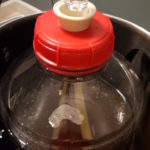
- 24 hours, a small krausen has formed. 🙂
- 40 hours, the krausen is now ~1/2 inch thick and pea green in color.
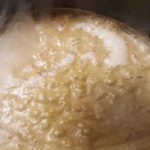
- 3 days
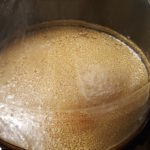
- 4 days, krausen has completely dropped out. Removed carboy for heat sink and raised fermentation chamber temperature to 72° to complete attenuation.
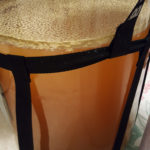
- 1 week, we’ve reached 1.010 FG! Has a delicious, light flowery hop flavor with a hint of ale esters compared to the lager. More taste comparisons will be required. 🙂
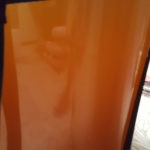
- 11 days, transferred into brew pot with 2.5 gallons of 34.5° water. Added gelatin finings once the temperature stabilized at 48° and dropped the temperature to 40° overnight.
- 13 days (2018-03-30), bottled brew. ?
Lager Yeast
- Pitched Mexican Lager yeast into 5 gallons of 53° wort. The temperature would not drop any further, even after pre-chilling the water entering the immersion chiller.
- Carboy was put into heat sink water bath that was cooled to 50°.
- Fermentation chamber is set to 52° with acceptable range of 50° to 53°. (hd 2°, cd 1°)
- 18 hours, lots of airlock activity and small 1/8″ krausen has formed. Heat sink temperature has increased from 50° to 52.1° overnight from yeast activity.

- 48 hours
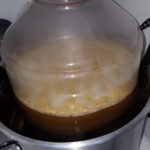
- 5 days, krausen has started dropping out. Raised fermentation chamber temperature 5° to 57° and will continue to raise temperature by 5° every 12 hours until reaching 68° for a diacetyl rest. (With an OG this low, I would raise the temperature at day 4 on the next brew.)
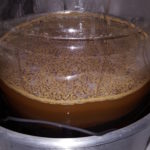
- 1 week, FG is 1.012 and has a delicious, clean, light flowery hop flavor.
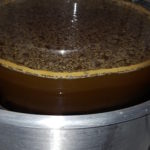
- 8 days, started dropping temperature to 50° and will fine with gelatin once desired temperature is achieved.
- 9 days, added gelatin finings at 46.5° and set fermentation chamber temperature to 33°.
- 11 days, transferred to keg to lager after beer cleared for two days at 34.5°.
- 25 days (2018-04-11), bottled the lager.